The primary IDE channel is the one next to the back up battery - it would have been good to see these rotated round 90 degrees to make connecting drives a little easier in the majority of cases on the market. Also, we feel that rotating the ports will help to improve cable management, too.
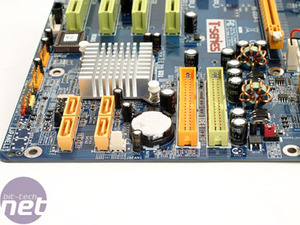
 The SATA ports are located to the left of the battery and one of the three-pin chassis fan headers. They are controlled by the NVIDIA nForce 430 MCP and support RAID 0, RAID 1, RAID 0+1, RAID 5 and JBOD configurations at transfer rates of up to 3Gb/sec, along with Native Command Queuing and hot swapping capabilities too. It's also worth noting that, due to the nature of NVIDIA's storage controller, the IDE ports support the same RAID functionality and it's possible to create RAID arrays across both IDE and SATA drives in the same array.
The SATA ports are located to the left of the battery and one of the three-pin chassis fan headers. They are controlled by the NVIDIA nForce 430 MCP and support RAID 0, RAID 1, RAID 0+1, RAID 5 and JBOD configurations at transfer rates of up to 3Gb/sec, along with Native Command Queuing and hot swapping capabilities too. It's also worth noting that, due to the nature of NVIDIA's storage controller, the IDE ports support the same RAID functionality and it's possible to create RAID arrays across both IDE and SATA drives in the same array.
To the left of the SATA ports, there is the CMOS reset jumper. This is reasonably well positioned, but it could have been better - at least it's not right under the PCI-Express x16 slot. if it was moved away from the SATA ports a little, it'd be easier to reset CMOS without having to remove cables from the board in order to get to it.
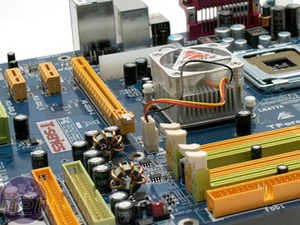
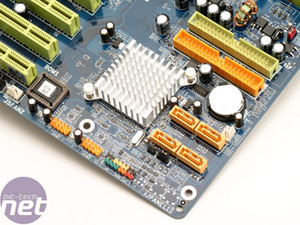 Along the left hand side of the board (in our overview shot), there is the front panel connections and two USB2.0 headers. Unfortunately, as aforementioned, there are no USB expansion brackets included in the bundle, so you'll have to source your own. It is, however, plausible to use the front USB2.0 port headers on your case if it supports front USB connections.
Along the left hand side of the board (in our overview shot), there is the front panel connections and two USB2.0 headers. Unfortunately, as aforementioned, there are no USB expansion brackets included in the bundle, so you'll have to source your own. It is, however, plausible to use the front USB2.0 port headers on your case if it supports front USB connections.
The BIOS chip is located in between the second USB2.0 header and the bottom PCI slot. On the left hand edge of the board, there is another three pin fan header along with a S/PDIF out header that supports a CDROM-style three pin connector.
It's not possible to remove the installed memory - or even install more memory - without removing the video card if you're planning on installing a video card that's longer than about 180mm. The positioning of this slot does have benefits, though. Biostar has managed to get a single PCI-Express x16 slot, two PCI-Express x1 slots and four PCI slots on the board - that's more expansion slots than most high-end boards boast these days.
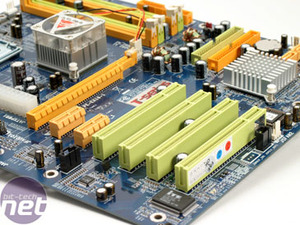
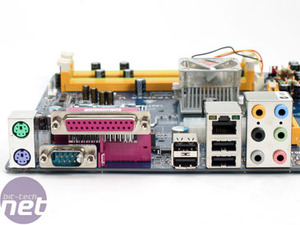 The board sports Realtek's ALC850 AC'97 audio codec. This is a bit of a disappointment, as NVIDIA stated that the Intel edition of its nForce4 Ultra chipset would support a high-definition audio codec. We can only assume that Biostar decided to save on production costs by implementing a lower-quality audio codec.
The board sports Realtek's ALC850 AC'97 audio codec. This is a bit of a disappointment, as NVIDIA stated that the Intel edition of its nForce4 Ultra chipset would support a high-definition audio codec. We can only assume that Biostar decided to save on production costs by implementing a lower-quality audio codec.
The other disappointment is the networking controller that Biostar has chosen to implement - instead of using a PCI-Express based Gigabit Ethernet controller, the company has decided to implement the Realtek 8201CL 10/100 PCI-based networking controller. If this was a secondary controller, it would be easy to overlook, but as a primary controller on a chipset that natively supports Gigabit Ethernet connections, it seems like a bit of an oversight.
The back panel is reasonably bare, but isn't rid of legacy connections - there is still a single serial port along with a parallel port too. Enthusiasts who don't want these connections will still be able to de-solder them, but we wish that more motherboard makers would remove the legacy connections from the back panel and replace them with something more useful - DFI, ABIT and Sapphire have all done it for a while now. Along with the two legacy connectors, you'll find the usual suspects on the TForce4 U 775's back panel. There are two PS/2 ports, four USB2.0 ports, ethernet socket and six audio ports supporting 7.1 channel audio via the ALC850 codec.


To the left of the SATA ports, there is the CMOS reset jumper. This is reasonably well positioned, but it could have been better - at least it's not right under the PCI-Express x16 slot. if it was moved away from the SATA ports a little, it'd be easier to reset CMOS without having to remove cables from the board in order to get to it.


The BIOS chip is located in between the second USB2.0 header and the bottom PCI slot. On the left hand edge of the board, there is another three pin fan header along with a S/PDIF out header that supports a CDROM-style three pin connector.
It's not possible to remove the installed memory - or even install more memory - without removing the video card if you're planning on installing a video card that's longer than about 180mm. The positioning of this slot does have benefits, though. Biostar has managed to get a single PCI-Express x16 slot, two PCI-Express x1 slots and four PCI slots on the board - that's more expansion slots than most high-end boards boast these days.


The other disappointment is the networking controller that Biostar has chosen to implement - instead of using a PCI-Express based Gigabit Ethernet controller, the company has decided to implement the Realtek 8201CL 10/100 PCI-based networking controller. If this was a secondary controller, it would be easy to overlook, but as a primary controller on a chipset that natively supports Gigabit Ethernet connections, it seems like a bit of an oversight.
The back panel is reasonably bare, but isn't rid of legacy connections - there is still a single serial port along with a parallel port too. Enthusiasts who don't want these connections will still be able to de-solder them, but we wish that more motherboard makers would remove the legacy connections from the back panel and replace them with something more useful - DFI, ABIT and Sapphire have all done it for a while now. Along with the two legacy connectors, you'll find the usual suspects on the TForce4 U 775's back panel. There are two PS/2 ports, four USB2.0 ports, ethernet socket and six audio ports supporting 7.1 channel audio via the ALC850 codec.

MSI MPG Velox 100R Chassis Review
October 14 2021 | 15:04








Want to comment? Please log in.